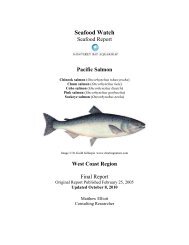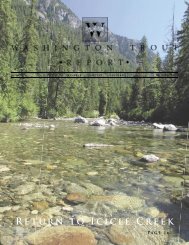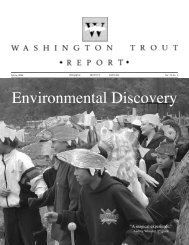Whidbey Island Near Shore Research Project
Washington Trout Report - Wild Fish Conservancy
Washington Trout Report - Wild Fish Conservancy
- No tags were found...
Create successful ePaper yourself
Turn your PDF publications into a flip-book with our unique Google optimized e-Paper software.
Juvenile Salmon and the Puget Sound <strong>Near</strong>shore<br />
West <strong>Whidbey</strong> Juvenile Fish-Use Assessment<br />
by Micah Wait; WT Conservation Ecologist<br />
WT field technicians conduct early morning sampling on a <strong>Whidbey</strong> <strong>Island</strong> beach. Photo: Kurt Beardslee<br />
I breathe deeply and the sharp smell of morning salt<br />
air hits my nose as the low February sun warms my face.<br />
My back and forearms register a dull ache, I try to shift the<br />
burden to my legs, and my feet dig deeper into the sand<br />
and gravel of the beach. I’m part of a team hauling in the<br />
free end of a 120 foot-long beach seine. One side of this<br />
net is tethered to large piece of driftwood on the beach<br />
dune, while this end, the one that barely moves when I lean<br />
my weight against it, had been attached to an aluminum<br />
mast mounted on the rear of our skiff. We use the boat to<br />
pull the fine-meshed net straight off of the beach and to<br />
hold the net steady against the tidal current. After a few<br />
minutes the boat is brought close to shore, and the seine,<br />
now shaped in a quarter circle, must be hauled in so that<br />
the curtain of netting forms a semi-circle, closed off by the<br />
beach.<br />
My end of the net is now securely on shore and the<br />
other members of our field crew join me in drawing the<br />
two ends of the net ashore. There are four of us on the<br />
beach, two on each end of the net. One person pulls in the<br />
float line that keeps the top of the net on the water surface,<br />
while one person pulls in the lead line that holds the net<br />
to the bottom. As we draw the ends of the net in to shore<br />
the semi circle of net shrinks smaller, until all that is left<br />
is a small pocket of net, squirming with marine life. On<br />
this set we have caught a handful of juvenile pink salmon,<br />
four species of sculpin and a shiner perch. We record the<br />
number and length of each fish, return them to the water,<br />
and prepare to set the net again.<br />
We are on the western shore of <strong>Whidbey</strong> <strong>Island</strong>,<br />
collecting samples in Washington Trout’s West <strong>Whidbey</strong><br />
WT Conservation Ecologist Micah Wait pilots the research vessel setting a<br />
beach seine. Photo: Dale Russell<br />
Juvenile Fish-Use Assessment. While Washington Trout<br />
has a well earned reputation for experience and expertise in<br />
salmonid-related field research in freshwater and estuarine<br />
environments, this is our first research project focusing on<br />
marine environments. The challenges, opportunities, and<br />
important new data have all been exciting.<br />
<strong>Whidbey</strong> <strong>Island</strong> is the long narrow land mass that<br />
makes up the eastern border of Admiralty Inlet. As tides<br />
flood and ebb Puget Sound and the Hood Canal, all that<br />
water passes through Admiralty Inlet. The salmon and<br />
steelhead that spawn in the rivers draining into the Sound<br />
and Canal pass through this bottleneck on their way to and<br />
from pelagic feeding grounds in the Pacific Ocean.<br />
4






